University Report: Health Information Systems and Strategic Planning
VerifiedAdded on 2020/04/15
|10
|2320
|174
Report
AI Summary
This report delves into the realm of Health Information Systems (HIS), examining the crucial role of the Chief Technology Officer (CTO) and the Chief Information Officer (CIO) in enhancing employee and patient satisfaction through effective digital strategies, including e-health records and digital signage. It explores the implementation of advanced technologies for improving healthcare processes, such as telemedicine and virtual interfaces, while also addressing the critical need for robust methods to prevent data misuse and protect patient privacy. The report emphasizes the importance of training programs for healthcare providers and outlines best practices for IT alignment and strategic planning initiatives, advocating for cross-functional collaboration, stakeholder engagement, and competitive analysis to ensure the successful integration of new technologies and achieve organizational goals. The report also highlights the importance of data encryption, vulnerability assessments and security awareness training to prevent data breaches.
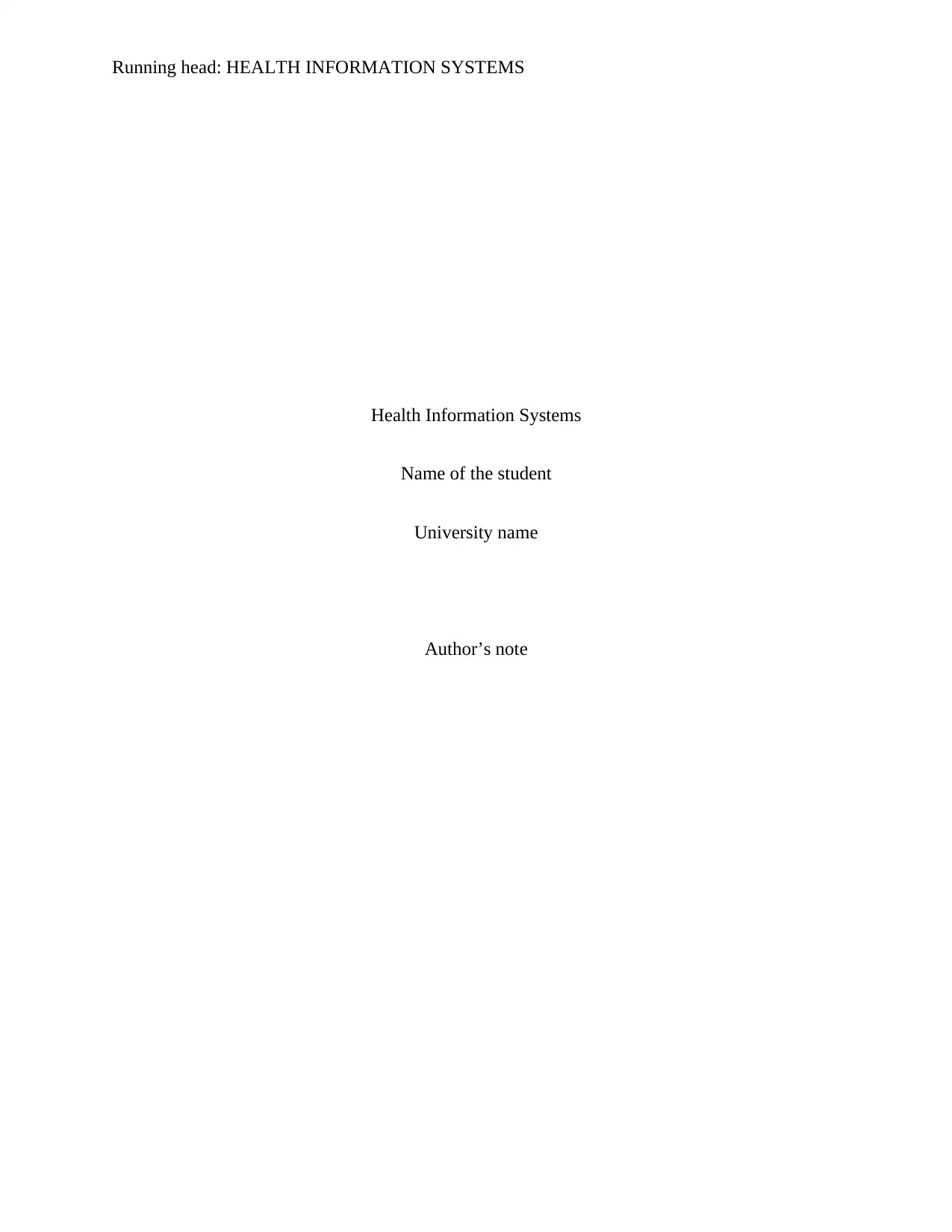
Running head: HEALTH INFORMATION SYSTEMS
Health Information Systems
Name of the student
University name
Author’s note
Health Information Systems
Name of the student
University name
Author’s note
Paraphrase This Document
Need a fresh take? Get an instant paraphrase of this document with our AI Paraphraser
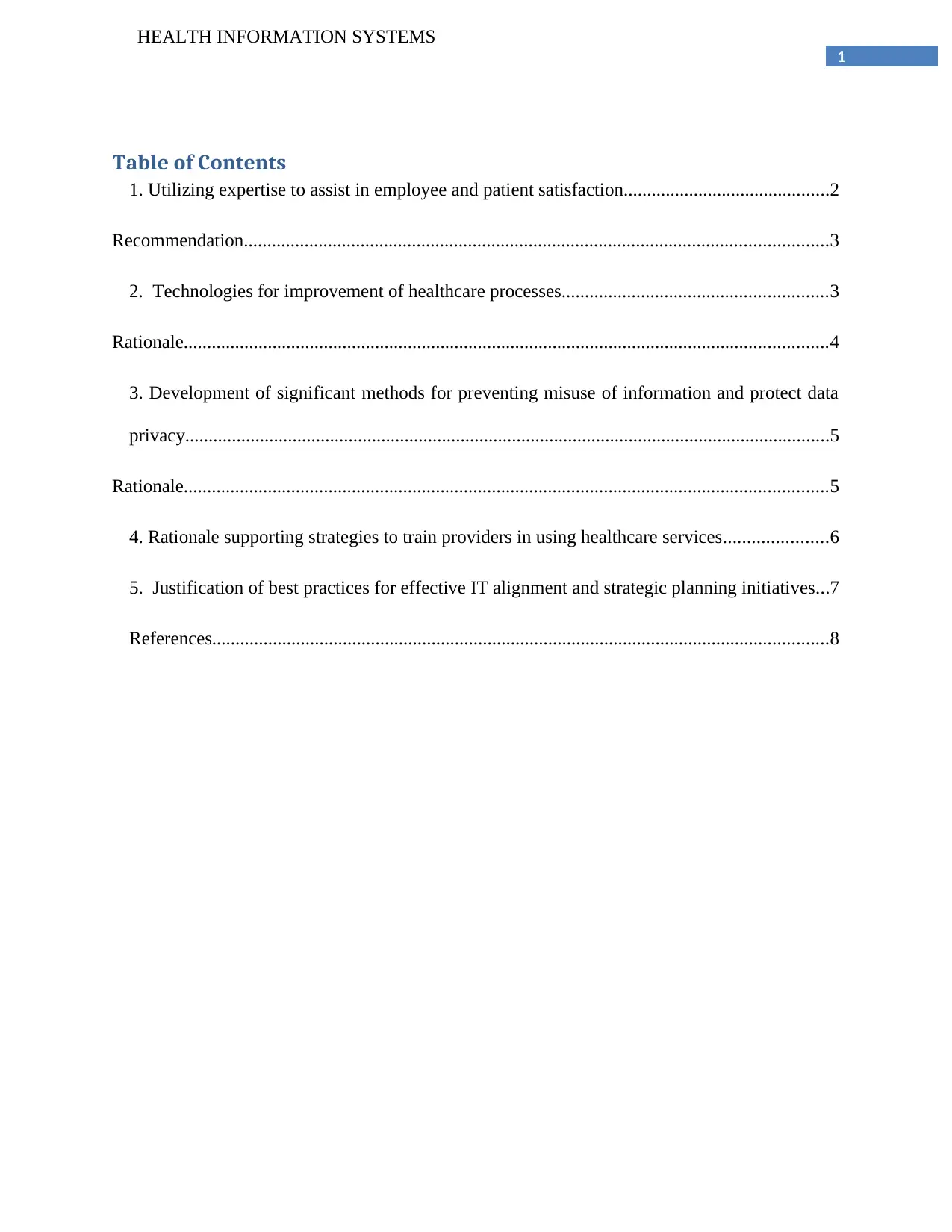
1
HEALTH INFORMATION SYSTEMS
Table of Contents
1. Utilizing expertise to assist in employee and patient satisfaction............................................2
Recommendation.............................................................................................................................3
2. Technologies for improvement of healthcare processes.........................................................3
Rationale..........................................................................................................................................4
3. Development of significant methods for preventing misuse of information and protect data
privacy..........................................................................................................................................5
Rationale..........................................................................................................................................5
4. Rationale supporting strategies to train providers in using healthcare services......................6
5. Justification of best practices for effective IT alignment and strategic planning initiatives...7
References....................................................................................................................................8
HEALTH INFORMATION SYSTEMS
Table of Contents
1. Utilizing expertise to assist in employee and patient satisfaction............................................2
Recommendation.............................................................................................................................3
2. Technologies for improvement of healthcare processes.........................................................3
Rationale..........................................................................................................................................4
3. Development of significant methods for preventing misuse of information and protect data
privacy..........................................................................................................................................5
Rationale..........................................................................................................................................5
4. Rationale supporting strategies to train providers in using healthcare services......................6
5. Justification of best practices for effective IT alignment and strategic planning initiatives...7
References....................................................................................................................................8
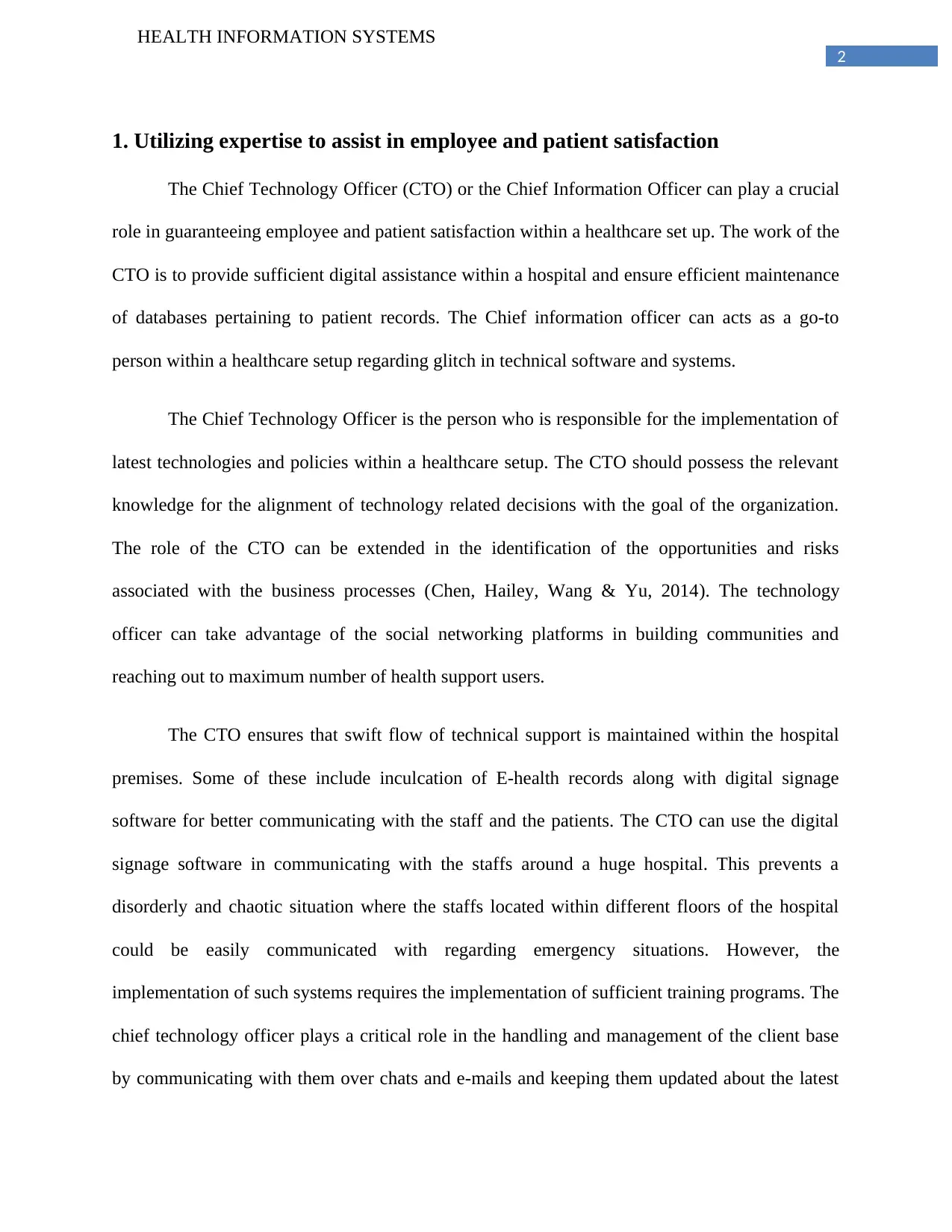
2
HEALTH INFORMATION SYSTEMS
1. Utilizing expertise to assist in employee and patient satisfaction
The Chief Technology Officer (CTO) or the Chief Information Officer can play a crucial
role in guaranteeing employee and patient satisfaction within a healthcare set up. The work of the
CTO is to provide sufficient digital assistance within a hospital and ensure efficient maintenance
of databases pertaining to patient records. The Chief information officer can acts as a go-to
person within a healthcare setup regarding glitch in technical software and systems.
The Chief Technology Officer is the person who is responsible for the implementation of
latest technologies and policies within a healthcare setup. The CTO should possess the relevant
knowledge for the alignment of technology related decisions with the goal of the organization.
The role of the CTO can be extended in the identification of the opportunities and risks
associated with the business processes (Chen, Hailey, Wang & Yu, 2014). The technology
officer can take advantage of the social networking platforms in building communities and
reaching out to maximum number of health support users.
The CTO ensures that swift flow of technical support is maintained within the hospital
premises. Some of these include inculcation of E-health records along with digital signage
software for better communicating with the staff and the patients. The CTO can use the digital
signage software in communicating with the staffs around a huge hospital. This prevents a
disorderly and chaotic situation where the staffs located within different floors of the hospital
could be easily communicated with regarding emergency situations. However, the
implementation of such systems requires the implementation of sufficient training programs. The
chief technology officer plays a critical role in the handling and management of the client base
by communicating with them over chats and e-mails and keeping them updated about the latest
HEALTH INFORMATION SYSTEMS
1. Utilizing expertise to assist in employee and patient satisfaction
The Chief Technology Officer (CTO) or the Chief Information Officer can play a crucial
role in guaranteeing employee and patient satisfaction within a healthcare set up. The work of the
CTO is to provide sufficient digital assistance within a hospital and ensure efficient maintenance
of databases pertaining to patient records. The Chief information officer can acts as a go-to
person within a healthcare setup regarding glitch in technical software and systems.
The Chief Technology Officer is the person who is responsible for the implementation of
latest technologies and policies within a healthcare setup. The CTO should possess the relevant
knowledge for the alignment of technology related decisions with the goal of the organization.
The role of the CTO can be extended in the identification of the opportunities and risks
associated with the business processes (Chen, Hailey, Wang & Yu, 2014). The technology
officer can take advantage of the social networking platforms in building communities and
reaching out to maximum number of health support users.
The CTO ensures that swift flow of technical support is maintained within the hospital
premises. Some of these include inculcation of E-health records along with digital signage
software for better communicating with the staff and the patients. The CTO can use the digital
signage software in communicating with the staffs around a huge hospital. This prevents a
disorderly and chaotic situation where the staffs located within different floors of the hospital
could be easily communicated with regarding emergency situations. However, the
implementation of such systems requires the implementation of sufficient training programs. The
chief technology officer plays a critical role in the handling and management of the client base
by communicating with them over chats and e-mails and keeping them updated about the latest
⊘ This is a preview!⊘
Do you want full access?
Subscribe today to unlock all pages.

Trusted by 1+ million students worldwide
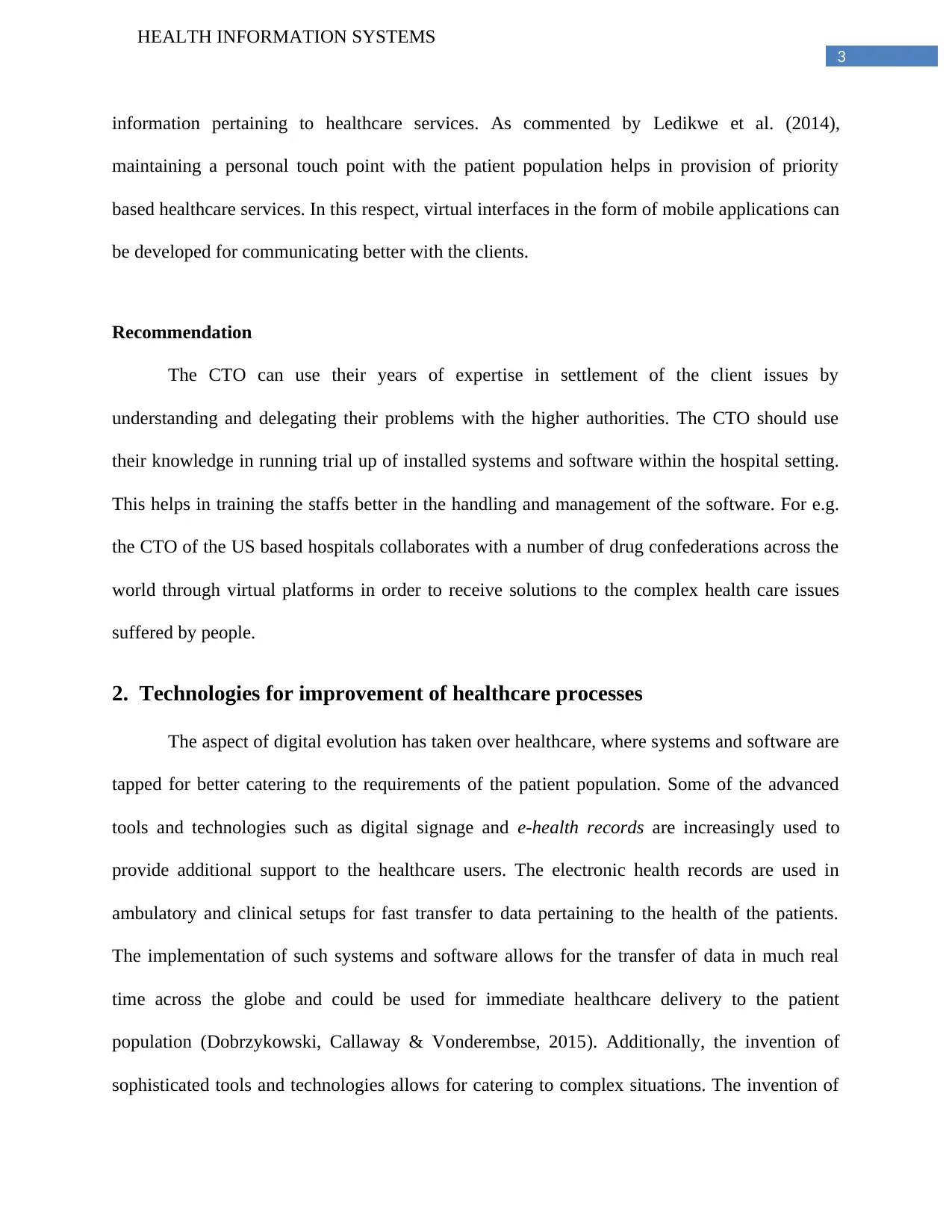
3
HEALTH INFORMATION SYSTEMS
information pertaining to healthcare services. As commented by Ledikwe et al. (2014),
maintaining a personal touch point with the patient population helps in provision of priority
based healthcare services. In this respect, virtual interfaces in the form of mobile applications can
be developed for communicating better with the clients.
Recommendation
The CTO can use their years of expertise in settlement of the client issues by
understanding and delegating their problems with the higher authorities. The CTO should use
their knowledge in running trial up of installed systems and software within the hospital setting.
This helps in training the staffs better in the handling and management of the software. For e.g.
the CTO of the US based hospitals collaborates with a number of drug confederations across the
world through virtual platforms in order to receive solutions to the complex health care issues
suffered by people.
2. Technologies for improvement of healthcare processes
The aspect of digital evolution has taken over healthcare, where systems and software are
tapped for better catering to the requirements of the patient population. Some of the advanced
tools and technologies such as digital signage and e-health records are increasingly used to
provide additional support to the healthcare users. The electronic health records are used in
ambulatory and clinical setups for fast transfer to data pertaining to the health of the patients.
The implementation of such systems and software allows for the transfer of data in much real
time across the globe and could be used for immediate healthcare delivery to the patient
population (Dobrzykowski, Callaway & Vonderembse, 2015). Additionally, the invention of
sophisticated tools and technologies allows for catering to complex situations. The invention of
HEALTH INFORMATION SYSTEMS
information pertaining to healthcare services. As commented by Ledikwe et al. (2014),
maintaining a personal touch point with the patient population helps in provision of priority
based healthcare services. In this respect, virtual interfaces in the form of mobile applications can
be developed for communicating better with the clients.
Recommendation
The CTO can use their years of expertise in settlement of the client issues by
understanding and delegating their problems with the higher authorities. The CTO should use
their knowledge in running trial up of installed systems and software within the hospital setting.
This helps in training the staffs better in the handling and management of the software. For e.g.
the CTO of the US based hospitals collaborates with a number of drug confederations across the
world through virtual platforms in order to receive solutions to the complex health care issues
suffered by people.
2. Technologies for improvement of healthcare processes
The aspect of digital evolution has taken over healthcare, where systems and software are
tapped for better catering to the requirements of the patient population. Some of the advanced
tools and technologies such as digital signage and e-health records are increasingly used to
provide additional support to the healthcare users. The electronic health records are used in
ambulatory and clinical setups for fast transfer to data pertaining to the health of the patients.
The implementation of such systems and software allows for the transfer of data in much real
time across the globe and could be used for immediate healthcare delivery to the patient
population (Dobrzykowski, Callaway & Vonderembse, 2015). Additionally, the invention of
sophisticated tools and technologies allows for catering to complex situations. The invention of
Paraphrase This Document
Need a fresh take? Get an instant paraphrase of this document with our AI Paraphraser
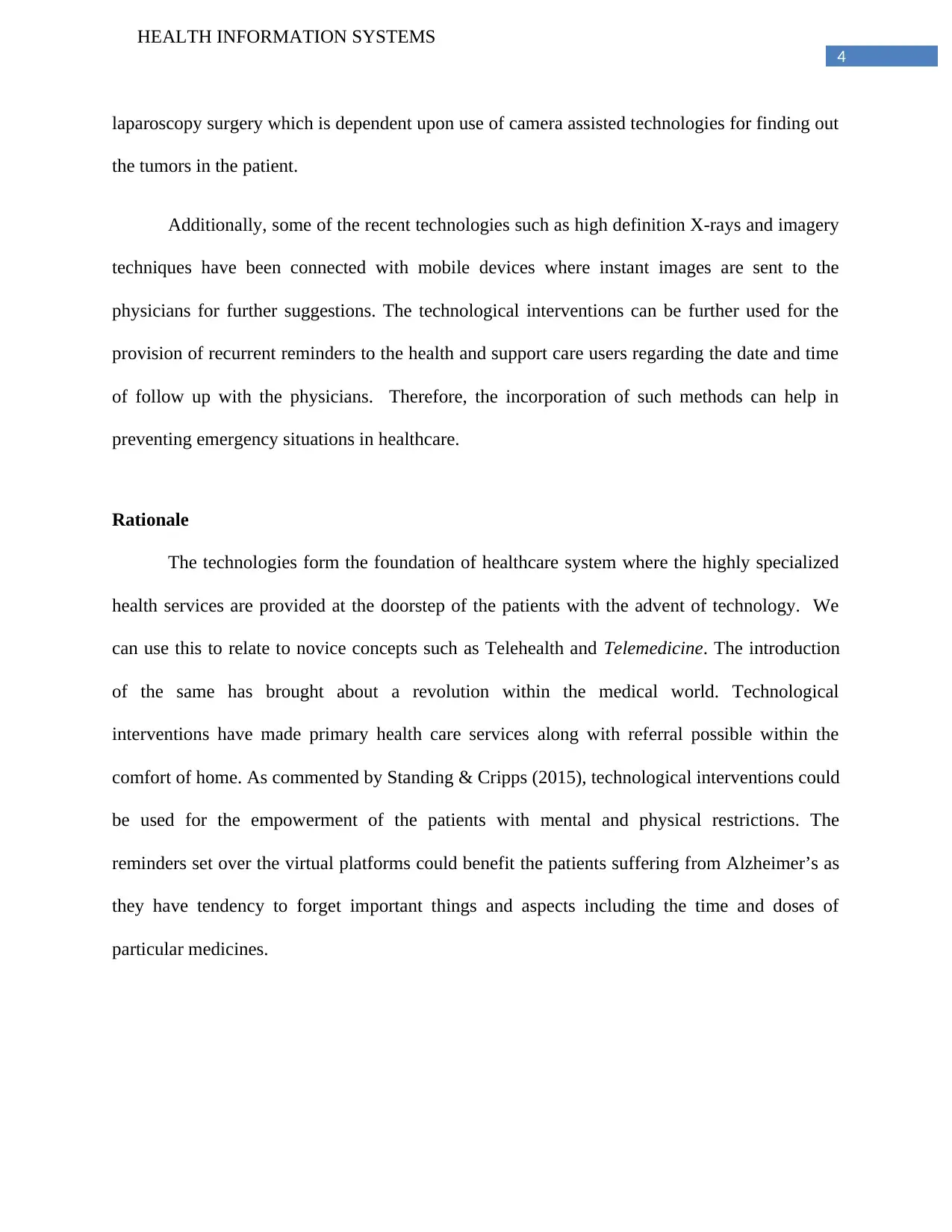
4
HEALTH INFORMATION SYSTEMS
laparoscopy surgery which is dependent upon use of camera assisted technologies for finding out
the tumors in the patient.
Additionally, some of the recent technologies such as high definition X-rays and imagery
techniques have been connected with mobile devices where instant images are sent to the
physicians for further suggestions. The technological interventions can be further used for the
provision of recurrent reminders to the health and support care users regarding the date and time
of follow up with the physicians. Therefore, the incorporation of such methods can help in
preventing emergency situations in healthcare.
Rationale
The technologies form the foundation of healthcare system where the highly specialized
health services are provided at the doorstep of the patients with the advent of technology. We
can use this to relate to novice concepts such as Telehealth and Telemedicine. The introduction
of the same has brought about a revolution within the medical world. Technological
interventions have made primary health care services along with referral possible within the
comfort of home. As commented by Standing & Cripps (2015), technological interventions could
be used for the empowerment of the patients with mental and physical restrictions. The
reminders set over the virtual platforms could benefit the patients suffering from Alzheimer’s as
they have tendency to forget important things and aspects including the time and doses of
particular medicines.
HEALTH INFORMATION SYSTEMS
laparoscopy surgery which is dependent upon use of camera assisted technologies for finding out
the tumors in the patient.
Additionally, some of the recent technologies such as high definition X-rays and imagery
techniques have been connected with mobile devices where instant images are sent to the
physicians for further suggestions. The technological interventions can be further used for the
provision of recurrent reminders to the health and support care users regarding the date and time
of follow up with the physicians. Therefore, the incorporation of such methods can help in
preventing emergency situations in healthcare.
Rationale
The technologies form the foundation of healthcare system where the highly specialized
health services are provided at the doorstep of the patients with the advent of technology. We
can use this to relate to novice concepts such as Telehealth and Telemedicine. The introduction
of the same has brought about a revolution within the medical world. Technological
interventions have made primary health care services along with referral possible within the
comfort of home. As commented by Standing & Cripps (2015), technological interventions could
be used for the empowerment of the patients with mental and physical restrictions. The
reminders set over the virtual platforms could benefit the patients suffering from Alzheimer’s as
they have tendency to forget important things and aspects including the time and doses of
particular medicines.
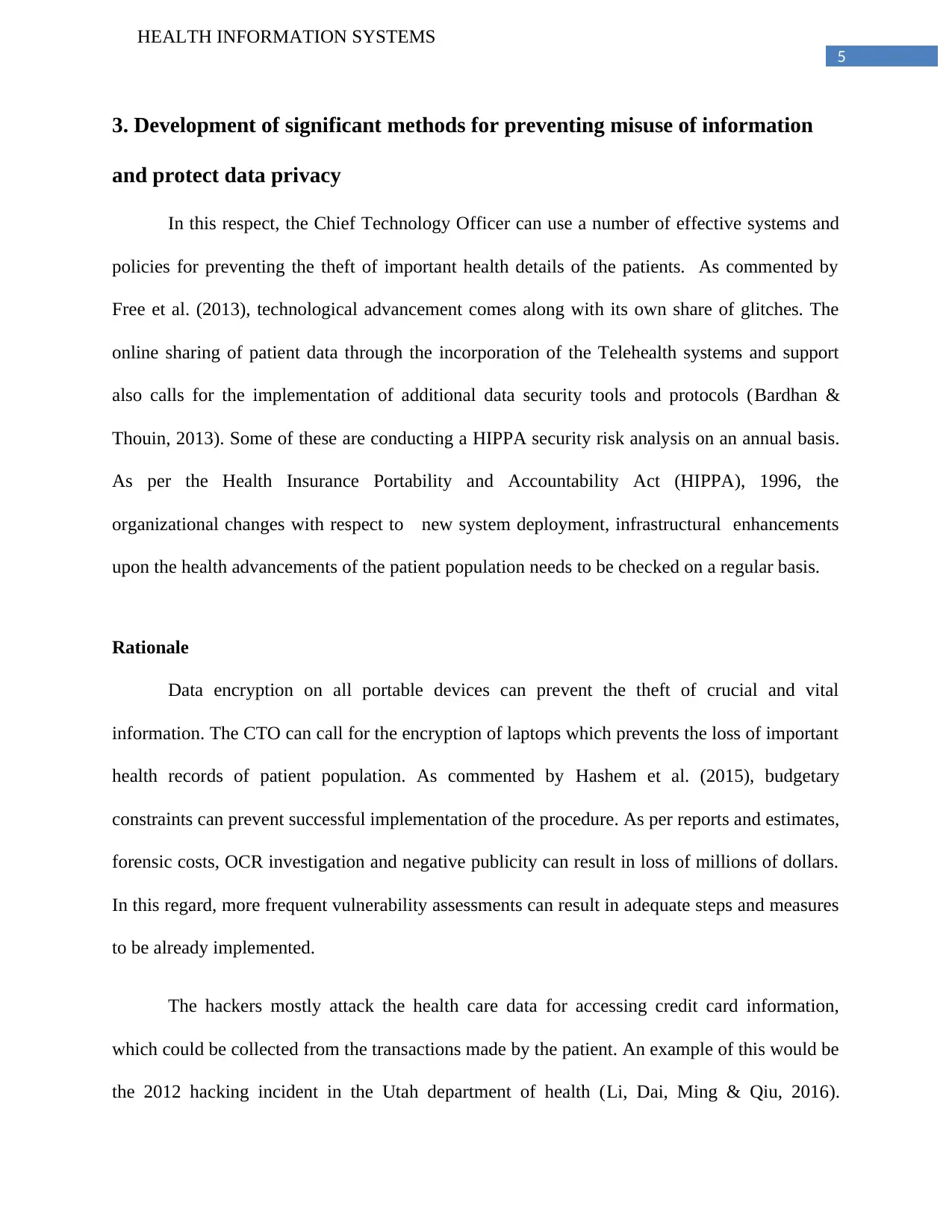
5
HEALTH INFORMATION SYSTEMS
3. Development of significant methods for preventing misuse of information
and protect data privacy
In this respect, the Chief Technology Officer can use a number of effective systems and
policies for preventing the theft of important health details of the patients. As commented by
Free et al. (2013), technological advancement comes along with its own share of glitches. The
online sharing of patient data through the incorporation of the Telehealth systems and support
also calls for the implementation of additional data security tools and protocols (Bardhan &
Thouin, 2013). Some of these are conducting a HIPPA security risk analysis on an annual basis.
As per the Health Insurance Portability and Accountability Act (HIPPA), 1996, the
organizational changes with respect to new system deployment, infrastructural enhancements
upon the health advancements of the patient population needs to be checked on a regular basis.
Rationale
Data encryption on all portable devices can prevent the theft of crucial and vital
information. The CTO can call for the encryption of laptops which prevents the loss of important
health records of patient population. As commented by Hashem et al. (2015), budgetary
constraints can prevent successful implementation of the procedure. As per reports and estimates,
forensic costs, OCR investigation and negative publicity can result in loss of millions of dollars.
In this regard, more frequent vulnerability assessments can result in adequate steps and measures
to be already implemented.
The hackers mostly attack the health care data for accessing credit card information,
which could be collected from the transactions made by the patient. An example of this would be
the 2012 hacking incident in the Utah department of health (Li, Dai, Ming & Qiu, 2016).
HEALTH INFORMATION SYSTEMS
3. Development of significant methods for preventing misuse of information
and protect data privacy
In this respect, the Chief Technology Officer can use a number of effective systems and
policies for preventing the theft of important health details of the patients. As commented by
Free et al. (2013), technological advancement comes along with its own share of glitches. The
online sharing of patient data through the incorporation of the Telehealth systems and support
also calls for the implementation of additional data security tools and protocols (Bardhan &
Thouin, 2013). Some of these are conducting a HIPPA security risk analysis on an annual basis.
As per the Health Insurance Portability and Accountability Act (HIPPA), 1996, the
organizational changes with respect to new system deployment, infrastructural enhancements
upon the health advancements of the patient population needs to be checked on a regular basis.
Rationale
Data encryption on all portable devices can prevent the theft of crucial and vital
information. The CTO can call for the encryption of laptops which prevents the loss of important
health records of patient population. As commented by Hashem et al. (2015), budgetary
constraints can prevent successful implementation of the procedure. As per reports and estimates,
forensic costs, OCR investigation and negative publicity can result in loss of millions of dollars.
In this regard, more frequent vulnerability assessments can result in adequate steps and measures
to be already implemented.
The hackers mostly attack the health care data for accessing credit card information,
which could be collected from the transactions made by the patient. An example of this would be
the 2012 hacking incident in the Utah department of health (Li, Dai, Ming & Qiu, 2016).
⊘ This is a preview!⊘
Do you want full access?
Subscribe today to unlock all pages.

Trusted by 1+ million students worldwide
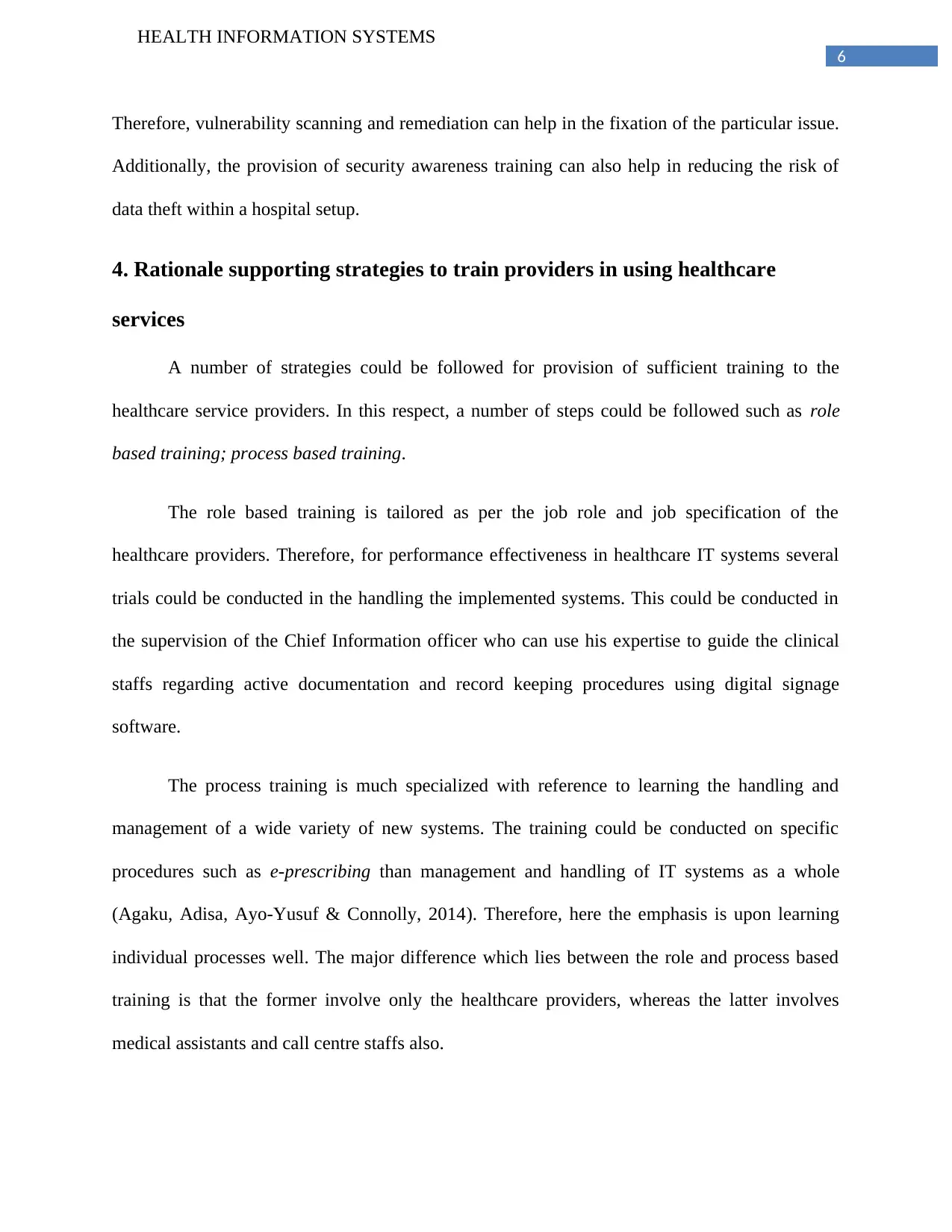
6
HEALTH INFORMATION SYSTEMS
Therefore, vulnerability scanning and remediation can help in the fixation of the particular issue.
Additionally, the provision of security awareness training can also help in reducing the risk of
data theft within a hospital setup.
4. Rationale supporting strategies to train providers in using healthcare
services
A number of strategies could be followed for provision of sufficient training to the
healthcare service providers. In this respect, a number of steps could be followed such as role
based training; process based training.
The role based training is tailored as per the job role and job specification of the
healthcare providers. Therefore, for performance effectiveness in healthcare IT systems several
trials could be conducted in the handling the implemented systems. This could be conducted in
the supervision of the Chief Information officer who can use his expertise to guide the clinical
staffs regarding active documentation and record keeping procedures using digital signage
software.
The process training is much specialized with reference to learning the handling and
management of a wide variety of new systems. The training could be conducted on specific
procedures such as e-prescribing than management and handling of IT systems as a whole
(Agaku, Adisa, Ayo-Yusuf & Connolly, 2014). Therefore, here the emphasis is upon learning
individual processes well. The major difference which lies between the role and process based
training is that the former involve only the healthcare providers, whereas the latter involves
medical assistants and call centre staffs also.
HEALTH INFORMATION SYSTEMS
Therefore, vulnerability scanning and remediation can help in the fixation of the particular issue.
Additionally, the provision of security awareness training can also help in reducing the risk of
data theft within a hospital setup.
4. Rationale supporting strategies to train providers in using healthcare
services
A number of strategies could be followed for provision of sufficient training to the
healthcare service providers. In this respect, a number of steps could be followed such as role
based training; process based training.
The role based training is tailored as per the job role and job specification of the
healthcare providers. Therefore, for performance effectiveness in healthcare IT systems several
trials could be conducted in the handling the implemented systems. This could be conducted in
the supervision of the Chief Information officer who can use his expertise to guide the clinical
staffs regarding active documentation and record keeping procedures using digital signage
software.
The process training is much specialized with reference to learning the handling and
management of a wide variety of new systems. The training could be conducted on specific
procedures such as e-prescribing than management and handling of IT systems as a whole
(Agaku, Adisa, Ayo-Yusuf & Connolly, 2014). Therefore, here the emphasis is upon learning
individual processes well. The major difference which lies between the role and process based
training is that the former involve only the healthcare providers, whereas the latter involves
medical assistants and call centre staffs also.
Paraphrase This Document
Need a fresh take? Get an instant paraphrase of this document with our AI Paraphraser
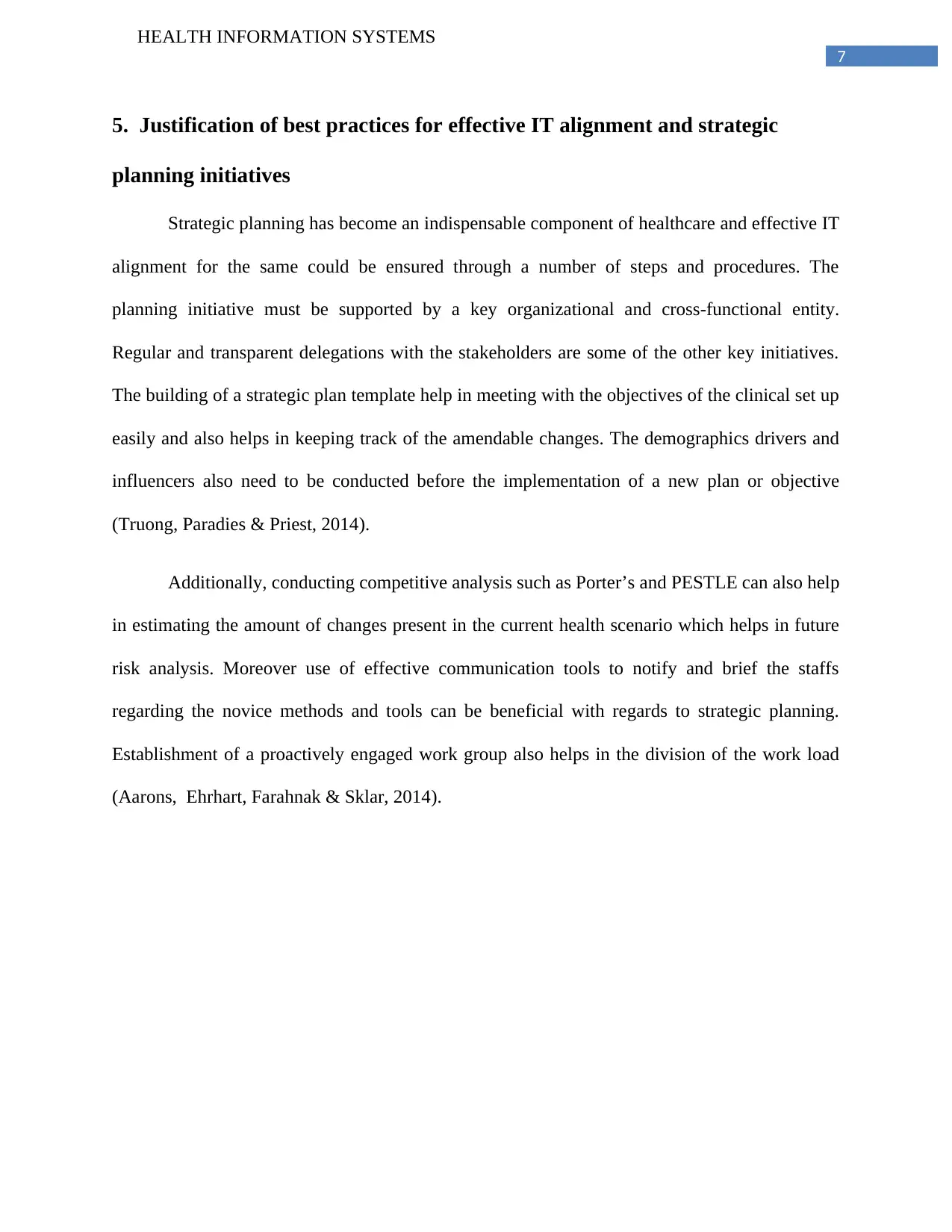
7
HEALTH INFORMATION SYSTEMS
5. Justification of best practices for effective IT alignment and strategic
planning initiatives
Strategic planning has become an indispensable component of healthcare and effective IT
alignment for the same could be ensured through a number of steps and procedures. The
planning initiative must be supported by a key organizational and cross-functional entity.
Regular and transparent delegations with the stakeholders are some of the other key initiatives.
The building of a strategic plan template help in meeting with the objectives of the clinical set up
easily and also helps in keeping track of the amendable changes. The demographics drivers and
influencers also need to be conducted before the implementation of a new plan or objective
(Truong, Paradies & Priest, 2014).
Additionally, conducting competitive analysis such as Porter’s and PESTLE can also help
in estimating the amount of changes present in the current health scenario which helps in future
risk analysis. Moreover use of effective communication tools to notify and brief the staffs
regarding the novice methods and tools can be beneficial with regards to strategic planning.
Establishment of a proactively engaged work group also helps in the division of the work load
(Aarons, Ehrhart, Farahnak & Sklar, 2014).
HEALTH INFORMATION SYSTEMS
5. Justification of best practices for effective IT alignment and strategic
planning initiatives
Strategic planning has become an indispensable component of healthcare and effective IT
alignment for the same could be ensured through a number of steps and procedures. The
planning initiative must be supported by a key organizational and cross-functional entity.
Regular and transparent delegations with the stakeholders are some of the other key initiatives.
The building of a strategic plan template help in meeting with the objectives of the clinical set up
easily and also helps in keeping track of the amendable changes. The demographics drivers and
influencers also need to be conducted before the implementation of a new plan or objective
(Truong, Paradies & Priest, 2014).
Additionally, conducting competitive analysis such as Porter’s and PESTLE can also help
in estimating the amount of changes present in the current health scenario which helps in future
risk analysis. Moreover use of effective communication tools to notify and brief the staffs
regarding the novice methods and tools can be beneficial with regards to strategic planning.
Establishment of a proactively engaged work group also helps in the division of the work load
(Aarons, Ehrhart, Farahnak & Sklar, 2014).
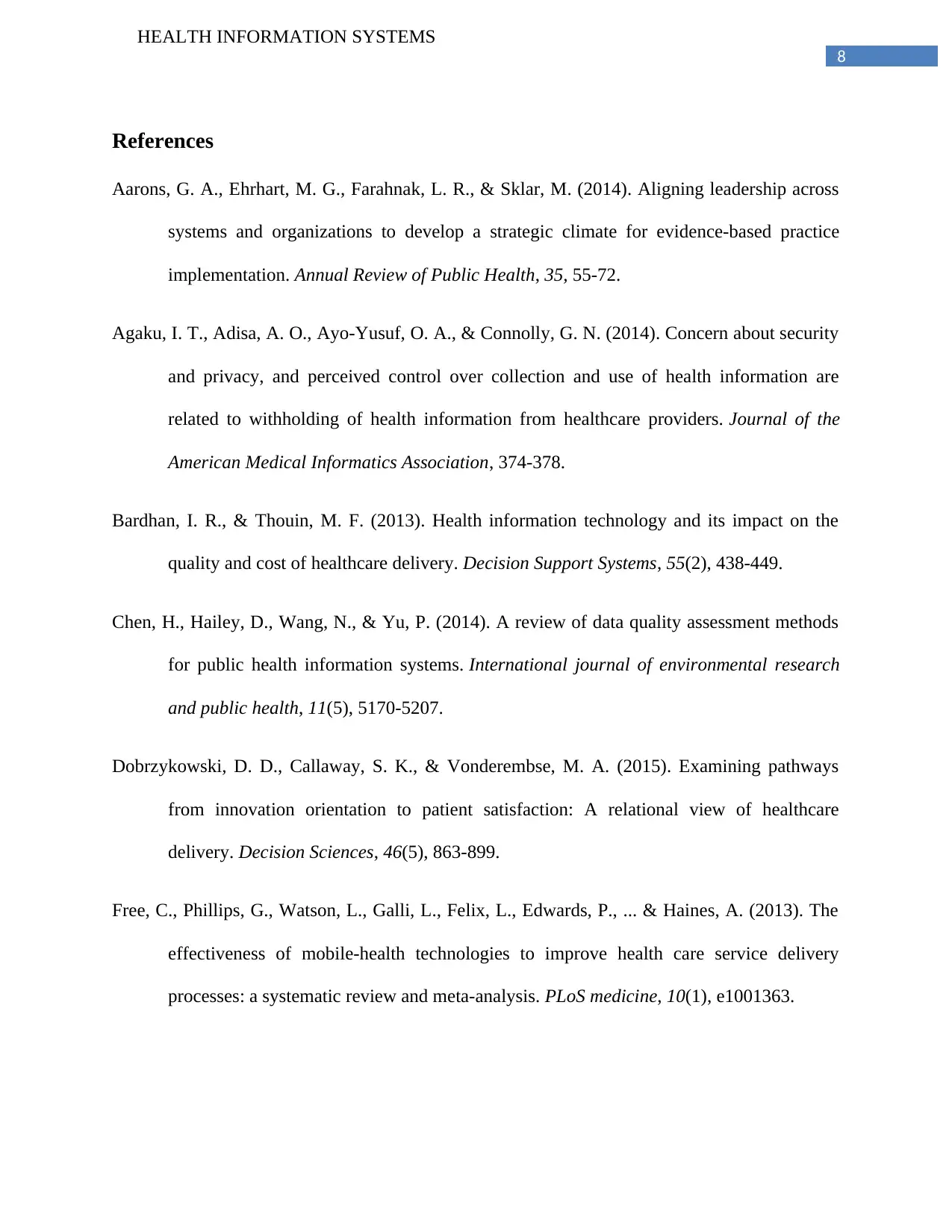
8
HEALTH INFORMATION SYSTEMS
References
Aarons, G. A., Ehrhart, M. G., Farahnak, L. R., & Sklar, M. (2014). Aligning leadership across
systems and organizations to develop a strategic climate for evidence-based practice
implementation. Annual Review of Public Health, 35, 55-72.
Agaku, I. T., Adisa, A. O., Ayo-Yusuf, O. A., & Connolly, G. N. (2014). Concern about security
and privacy, and perceived control over collection and use of health information are
related to withholding of health information from healthcare providers. Journal of the
American Medical Informatics Association, 374-378.
Bardhan, I. R., & Thouin, M. F. (2013). Health information technology and its impact on the
quality and cost of healthcare delivery. Decision Support Systems, 55(2), 438-449.
Chen, H., Hailey, D., Wang, N., & Yu, P. (2014). A review of data quality assessment methods
for public health information systems. International journal of environmental research
and public health, 11(5), 5170-5207.
Dobrzykowski, D. D., Callaway, S. K., & Vonderembse, M. A. (2015). Examining pathways
from innovation orientation to patient satisfaction: A relational view of healthcare
delivery. Decision Sciences, 46(5), 863-899.
Free, C., Phillips, G., Watson, L., Galli, L., Felix, L., Edwards, P., ... & Haines, A. (2013). The
effectiveness of mobile-health technologies to improve health care service delivery
processes: a systematic review and meta-analysis. PLoS medicine, 10(1), e1001363.
HEALTH INFORMATION SYSTEMS
References
Aarons, G. A., Ehrhart, M. G., Farahnak, L. R., & Sklar, M. (2014). Aligning leadership across
systems and organizations to develop a strategic climate for evidence-based practice
implementation. Annual Review of Public Health, 35, 55-72.
Agaku, I. T., Adisa, A. O., Ayo-Yusuf, O. A., & Connolly, G. N. (2014). Concern about security
and privacy, and perceived control over collection and use of health information are
related to withholding of health information from healthcare providers. Journal of the
American Medical Informatics Association, 374-378.
Bardhan, I. R., & Thouin, M. F. (2013). Health information technology and its impact on the
quality and cost of healthcare delivery. Decision Support Systems, 55(2), 438-449.
Chen, H., Hailey, D., Wang, N., & Yu, P. (2014). A review of data quality assessment methods
for public health information systems. International journal of environmental research
and public health, 11(5), 5170-5207.
Dobrzykowski, D. D., Callaway, S. K., & Vonderembse, M. A. (2015). Examining pathways
from innovation orientation to patient satisfaction: A relational view of healthcare
delivery. Decision Sciences, 46(5), 863-899.
Free, C., Phillips, G., Watson, L., Galli, L., Felix, L., Edwards, P., ... & Haines, A. (2013). The
effectiveness of mobile-health technologies to improve health care service delivery
processes: a systematic review and meta-analysis. PLoS medicine, 10(1), e1001363.
⊘ This is a preview!⊘
Do you want full access?
Subscribe today to unlock all pages.

Trusted by 1+ million students worldwide
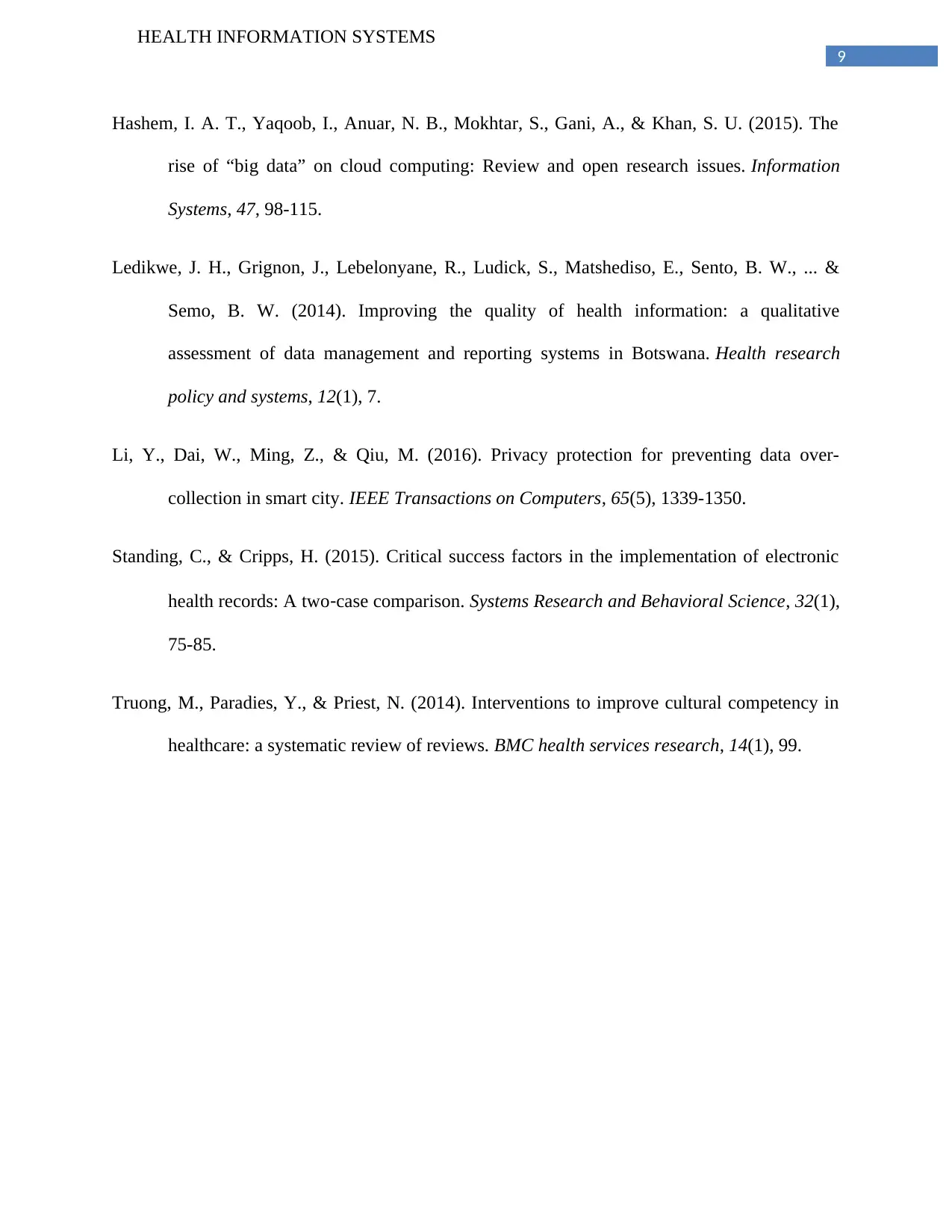
9
HEALTH INFORMATION SYSTEMS
Hashem, I. A. T., Yaqoob, I., Anuar, N. B., Mokhtar, S., Gani, A., & Khan, S. U. (2015). The
rise of “big data” on cloud computing: Review and open research issues. Information
Systems, 47, 98-115.
Ledikwe, J. H., Grignon, J., Lebelonyane, R., Ludick, S., Matshediso, E., Sento, B. W., ... &
Semo, B. W. (2014). Improving the quality of health information: a qualitative
assessment of data management and reporting systems in Botswana. Health research
policy and systems, 12(1), 7.
Li, Y., Dai, W., Ming, Z., & Qiu, M. (2016). Privacy protection for preventing data over-
collection in smart city. IEEE Transactions on Computers, 65(5), 1339-1350.
Standing, C., & Cripps, H. (2015). Critical success factors in the implementation of electronic
health records: A two‐case comparison. Systems Research and Behavioral Science, 32(1),
75-85.
Truong, M., Paradies, Y., & Priest, N. (2014). Interventions to improve cultural competency in
healthcare: a systematic review of reviews. BMC health services research, 14(1), 99.
HEALTH INFORMATION SYSTEMS
Hashem, I. A. T., Yaqoob, I., Anuar, N. B., Mokhtar, S., Gani, A., & Khan, S. U. (2015). The
rise of “big data” on cloud computing: Review and open research issues. Information
Systems, 47, 98-115.
Ledikwe, J. H., Grignon, J., Lebelonyane, R., Ludick, S., Matshediso, E., Sento, B. W., ... &
Semo, B. W. (2014). Improving the quality of health information: a qualitative
assessment of data management and reporting systems in Botswana. Health research
policy and systems, 12(1), 7.
Li, Y., Dai, W., Ming, Z., & Qiu, M. (2016). Privacy protection for preventing data over-
collection in smart city. IEEE Transactions on Computers, 65(5), 1339-1350.
Standing, C., & Cripps, H. (2015). Critical success factors in the implementation of electronic
health records: A two‐case comparison. Systems Research and Behavioral Science, 32(1),
75-85.
Truong, M., Paradies, Y., & Priest, N. (2014). Interventions to improve cultural competency in
healthcare: a systematic review of reviews. BMC health services research, 14(1), 99.
1 out of 10
Related Documents
Your All-in-One AI-Powered Toolkit for Academic Success.
+13062052269
info@desklib.com
Available 24*7 on WhatsApp / Email
![[object Object]](/_next/static/media/star-bottom.7253800d.svg)
Unlock your academic potential
Copyright © 2020–2025 A2Z Services. All Rights Reserved. Developed and managed by ZUCOL.




